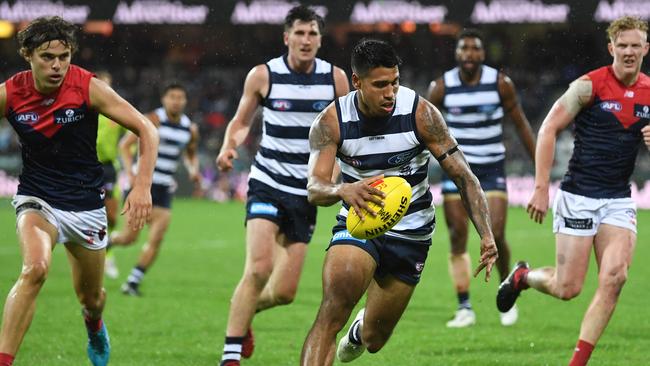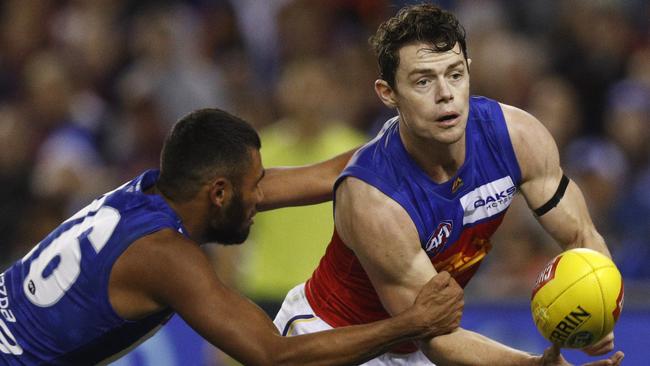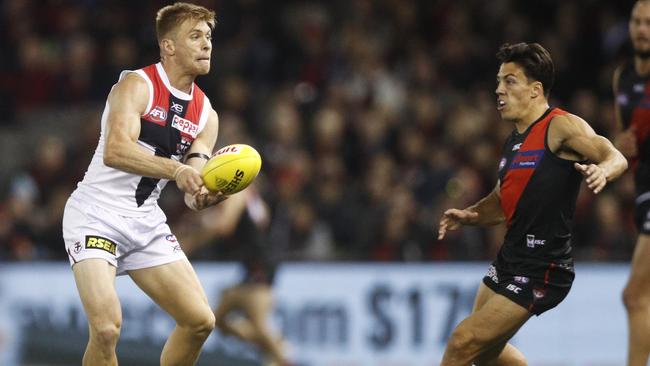The new 6-6-6 rule is providing a challenge for coaches, writes Mick Malthouse
Coaches and players are still getting their heads around the 6-6-6 zone rule as MICK MALTHOUSE reveals how he would combat the change and which clubs have benefited most.

Expert Opinion
Don't miss out on the headlines from Expert Opinion. Followed categories will be added to My News.
Let’s be clear ... footy fans go through the turnstiles to see their team win.
Or, if it isn’t equipped to win with talent alone, then at the very least have the capacity to challenge.
For the past 100-plus years of footy, coaches have had the ability to defend a lead, or plug a gap and halt the opposition’s momentum with a simple defensive mechanism — an extra man behind the ball at the centre bounce.
FIRST GAME: HAWKS REVEAL PLANS FOR WINGARD
ROBBO: WALLSY ‘A MENTOR, NOT A SPY’, BLUES SAY
MONEYBALL: HOW DE GOEY’S LOYALTY CHANGED PIES
This tactic can be challenged by an opposition coach in a number of ways, for example: move your extra directly on to the loose player for a seven-man forward line; counter it with your run off the backline with your extra; or throw your extra into the stoppage after the centre bounce, thereby giving your team a plus-one advantage at the stoppage.
Tactics. Beautiful, invigorating, game-changing tactics.
With the new 6-6-6 zone rule the extra-man weapon is no longer available.
When the Western Bulldogs had all the momentum against Hawthorn last round, having coached against Alastair Clarkson in similar circumstances, I know he would have liked to deploy a Jack Gunston-type behind the ball to pull back the lead. But he couldn’t.
The Hawks were overwhelmed and eventually beaten as time and time again the Dogs cleared the centre square.
Supporters don’t want you sitting on your hands doing nothing to change the outcome of the game. As a coach, you want to win. That’s it.
Don’t worry about high marking and open spaces, you want to use every weapon in your arsenal to combat the opposition.
Aesthetically, 6-6-6 looks good, like a board game or under-10s football. And it has benefited certain teams that’s for sure.

It comes down to a basic rate of attrition and it’s how the ball was cleared that matters.
The team that wins the match is likely to be the team that cleared the ball quickly and cleanly into a strong forward line (like Geelong) because if you lose in the midfield then you have to resurrect the ball in the backline, which becomes tiresome after four quarters.
Melbourne went inside 50 more often last round against Geelong, but it wasn’t the product of the number of clearances, it was the quality, or lack of, which hurt the Demons.
Class is hard to beat.
Amazingly, Geelong has scored 198 points in the opening two rounds, but only nine of those points have come directly from a centre-clearance.
Brisbane has clearly been aided by the new rule with a reasonably quick midfield and a young talented forward line to finish off the work.
The Lions are second on the ladder with two wins, and top of the ladder for scoring from the centre-bounce (61 points).
Sunday’s game will be a test to see if North Melbourne can restrict Hawthorn’s entry into a highly productive forward line.
While North has a good ruckman they don’t have the leg speed or the ball-getting power to capitalise on the 6-6-6 set up.
They were smoked by Fremantle and overwhelmed by the Brisbane Lions.

I said at the start of the season that North would make the finals, but now I don’t see the Kangaroos getting close to the final eight if they are not allowed to protect against a blowout with an extra man in defence.
They are at the bottom of the ladder for centre clearances and it doesn’t help that they are delivering into a one-man (Ben Brown) forward line.
The St Kilda and Fremantle clash will also be of great interest.
The Saints have midfield strength in Seb Ross, butthe Dockers have the and physical presence of Nat Fyfe and David Mundy.
Both forward lines have the capacity to benefit from a quick clearance without interference from the “seventh” defender.
If I was coaching Collingwood or West Coast, I’d be delighted with the 6-6-6 rule as each has a powerful midfield and a high-scoring forward line. Though through sheer nature I would still like to reinforce my backline.
I’d be sacrificing my winger by getting him to start right on the defensive edge of the centre square so he can get straight in behind the ball after the bounce. But this exposes the wing, which isn’t ideal either.
Most coaches like security, but that doesn’t add up to 6-6-6, it equals 5-6-7.
A slight adjustment to the new rule could create this, but I don’t see it happening.

Coaches and players learn to cope with most new rules that are thrown at them because it generally comes down to interpretation or a slight adjustment.
But it seems this season coaches are on a wing and a prayer.
It has never been clearer to me the true value of the coach’s role within the two hours of game time.
During the week they teach and nurture, they explore, explain and devise.
Coaching during a game is about making the right moves at the right time to aid momentum or stifle a run-on. And there are consequences if you’re too late to make a change.
Without regular use of a runner I’ve seen more coaching from the boundary line this year than ever before.
I’ve seen them using sign language and people on the boundary line holding up screens and placards with instructions in code. It’s ridiculous. And quite frankly, untidy.
You can instruct your players first-hand from the ground, which is a plus, but what you gain from that you lose from your perspective of the game from high up in the coaches’ box.
In the box you are also on the receiving end of information from your support crew — your assistant coaches and statisticians — which allows you to make decisions on the go during a game. I’m not sure a headset allows for the full effect of this communication.
So coaches are frustratingly torn as to where to place themselves for the benefit of the team.
I have seen quite a few matches this year where very few goals were scored in a quarter which means the runner can’t get on to the ground often enough to make momentum-shifting moves.
You can’t plan for this during the week because every game and every circumstance during a game is different.
There will be certain tactics and plays learned and practised during the week for what ifs — that has always happened — but teams are being left exposed and vulnerable when their coach’s hands are so tied up he can’t get a single message to his player in the very moment that he needs to.

Playing on from a point has been a challenge to the rules from the word go, but with the addition of the new backline kick-in rule there is no benefit to the ball handler, the scoreline, or to the supporter for that matter.
I’ve seen a tendency thus far for the man with the ball to run out of the goal square for 20 to 25m without a bounce (to the blind eye of the umpire) and then bomb it long to a scrap. Then the ball invariably comes back to him or at best there’s a boundary thrown in.
Our game is such a mobile non-stop battle that the players need a breather and the supporters need time to digest what is happening.
Almost gone is the Zach Tuohy or Shannon Hurn weapon of threading the ball through to a target in the centre square. More’s the pity.
Only eight teams scored more than 100 points in a match by the end of Round 2.
If the AFL wanted a pleasant-looking, free-flowing, high-scoring, open-field game, it’s created lower-scoring contests, ugly sideline scenes, player fatigue, coaching frustration and supporter confusion.
I hope we don’t see the runner phased out entirely, or rotations reduced further, or the 6-6-6 zone set up remain, because surely, the only way is up from here.
Originally published as The new 6-6-6 rule is providing a challenge for coaches, writes Mick Malthouse


